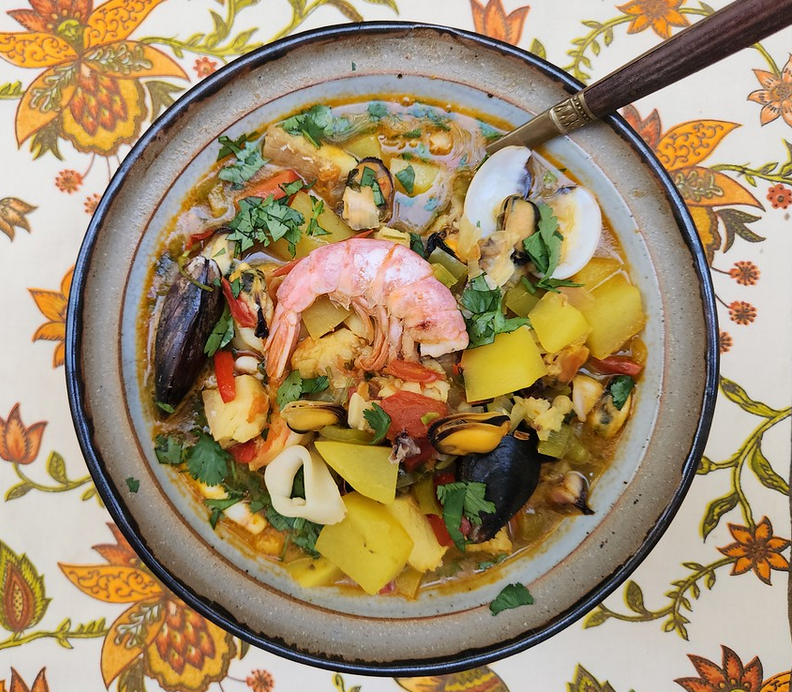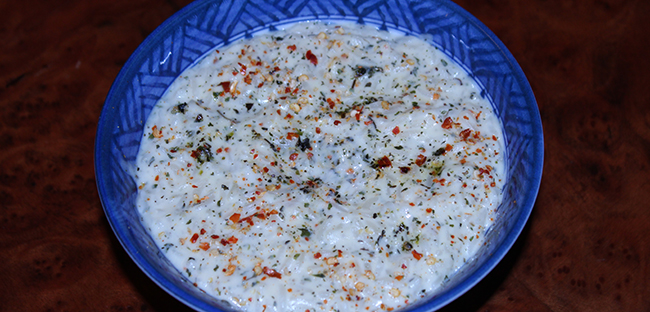
Yayla Çorbası is a savory yogurt and rice soup that is eaten throughout Turkey. It is very easy to prepare and the dried mint imparts a unique taste.
Soups are very popular in Turkey and come in many different varieties. This yogurt based soup, Yayla Çorbasi, which translates as "Meadow Soup", has its origins in the mountains in Turkey. It was mainly "drunk" (as you would say in Turkish) by the shepherds and their families. It is now regularly enjoyed throughout Turkey, both in small villages and large cities and is consumed for breakfast or as a complete meal. Although it is a winter favorite, it is offered throughout the year in homes and restaurants and is also a very popular street food. Like chicken soup in other cultures, Turkish folk beliefs contend that it has curative powers. Although it is often referred to as a soup because of the rice, it is more akin to a porridge.
The type of rice used in Yayla Çorbasi varies from recipe to recipe, with some calling for long-grain Basmati rice and others suggesting shorter grain rice. Whole grain rice will impart a slight nutty taste to the soup. Most recipes use rice, but barley, chickpeas or bulgur can also be used. When boiled, yogurt will separate and curdle and the soup will become thin. Therefore, you should add the yoghurt at the very end, heating it, but not to the point of a boil. The recipe below uses flour and egg which prevent the yogurt from curdling. Some versions use paprika while others use chili flakes for an extra kick. Turkish yogurt and dried mint can be purchased at the Balboa International Market.
Ingredients:
- 5 cups water, or vegetable or chicken/beef stock
- 1 cup rice
- 1 cup plain yogurt
- 1 tablespoon all-purpose flour
- 2 egg yolks
- 2 tablespoons olive oil
- 1/4 cup dried mint
- 2 teaspoons of paprika
- 1/3 teaspoon chili flakes
Preparation:
- Bring the water or stock to boil in saucepan.
- Add rice, turn down to simmer and cook for 20 minutes.
- Combine the yogurt, flour, egg yolk in a bowl and beat until smooth (the flour and egg yolks stabilize the yogurt and keep it from curdling).
- In a separate pan, saute the dried mint and paprika in the olive oil.
- Gently sauté the dried mint and paprika for a minute or so, but don't let the butter burn!
- Adding a quarter of a cup at a time, mix the remaining hot stock to the yoghurt.
- Mix the mixture into the rice and heat for another 5 minutes (avoid boiling!).
- Serve in bowls. Sprinkle top with chili flakes
Afiyet olsun!
Photo and recipe by T. Johnston-0'Neill
Recipe suggested by Henriette Ruhrmann
- Details
- Hits: 4205
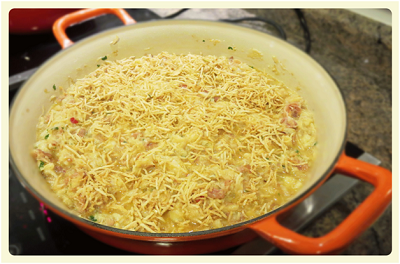
Bacalhau Que Nunca Chega is a cod, potato, and egg dish originates in Portugal but is very popular in Brazil as well. The literal English translation of this dish's name is, "Never enough cod". Popular in Brazil, the dish is of Portuguese origin. Legend has it that Portuguese King Carlos I unexpectedly returned from a battle and demanded to be fed. Surprised by the arrival of the king, the royal chef had scarce provisions in the castle. He did, however, have some salted cod (cod preserved in salt), some ham, a few onions and some potatoes. The King and the Royal Court were so impressed with the dish that, much to the chagrin of the cook, they demanded it again and again. Exasperated, the cook cried, "There is never enough cod!".
Cod dishes like Bacalhau Que Nunca Chega are particularly popular during Good Friday and Easter celebrations when eating fish is a religious tradition amongst Catholics. It is also a common dish in many of the more upscale restaurants in São Paulo.
For centuries cod and other fish have been preserved in salt, as this was the only way for it to survive the long boat journey back to shore. With modern refrigeration and quicker modes of transportation, this is no longer necessary. However, in Portugal and Brazil, salted cod is still the norm. In both countries, shredded cod comes in packs that don't need refrigeration or can be bought in large strips from supermarkets and delis. To make it palatable, salted cod needs to be soaked in several changes of water for one or two days. However, due to the unavailability of salt cod here in the US, this recipe uses fresh or thawed cod available everywhere.
The recipe also calls for deep fried shoestring potatoes. You can either cut the potatoes with a knife, use a mandolin grater with a julienne feature or shred the potato. As the photo shows, the potatoes are cut rather thinly. They resemble riced potatoes, but they are cut raw and then fried before being added to the dish.
Ingredients:
- Wash and peel the potatoes.
- Cut the potato using a method of your choice.
- Deep fat fry the potatoes until lightly brown and crispy.
- Drain the potatoes on a paper towel.
- Boil the cod for five minutes and then remove the cod and set it aside to cool.
- Shred the cod with your fingers or a fork.
- Heat the olive oil in a saute or frying pan.
- Brown the onions and 4 cloves of garlic.
- Nix in the cod an paprika to pan.
- Cover the pan and simmer on low heat for 20 minutes.
- In another frying pan, fry the prosciutto in a little oil until crisp.
- Add the remaining 2 garlic cloves and cook until brown.
- Slightly beat the eggs.
- In the pan with the cod, mix all the ingredients (except the parsley) and cook until the eggs are lightly cooked. Do not overcook; you want the potato sticks to remain crisp.
- Add salt and pepper to taste and garnish with chopped parsley and serve
Recipe and photo by Flavia Ferraretto
Her blog (in Portuguese) can be found here: www.eventos-inventos.blogspot.com
- Details
- Hits: 3976
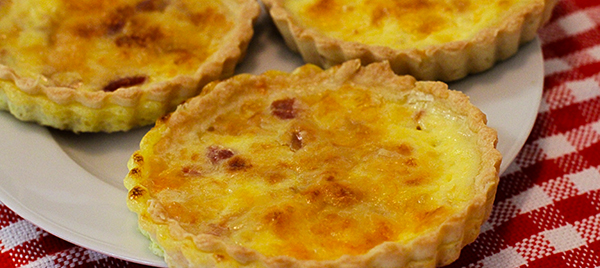
Quiche Lorraine is a quintessential French dish... or is it?
Quiche is a savory open pie with a filling that consists of cream, eggs, and traditionally bacon. Today you can enjoy quiches with a variety of fillings such as leeks, spinach, arugula, mushrooms, seafood, salmon and cheeses like Parmesan, Gruyere, Emmenthal Camembert, Roquefort or even Brie.
The word "quiche" comes from the German Kuchen meaning "cake." Quiche is thought to have originated from Alsace Lorraine, now part of northeastern France and bordering Germany. Historically the region has changed hands many times between France and Germany, and it is believed that quiche was first made when the area was a German province, Lothringen, which is "Lorraine" in French. When France regained Alsace Lorraine in 1945, the French declared the name of the dish to be "Quiche Lorraine."
After World War II, quiche gained admirers in England and then became popular in the United States. It is now known and appreciated throughout the world as a light and tasty dish to serve at any time of the year
The dough used to make a quiche is pâte brisée, a rich pastry based on butter and flour. While the quiche is a kind of pie, it differs from others in that it is open and includes whipping cream, eggs, nutmeg, and bacon, which are traditional ingredients found in the cuisine of Lorraine. More recently cheese has become a very popular ingredient as well. Reflecting its rustic roots, the dish traditionally cooking in cast iron pans, but now is typically cooked in special quiche or pie pans. Quiche can be served for lunch, dinner, afternoon coffee, or as a side or main dish. The recipe below uses traditional ingredients, but cooks can be as creative as they want with the filling.
Ingredients:
- 1 1/4 cups all-purpose flour
- 2 tablespoons white sugar
- 4 ounces butter at room temperature or butter in pommade
- 1 egg
- 2 tablespoon cold water
- salt
Filling:
- 3 slices bacon, crisply cooked, crumbled
- 1 cup or 4 ounces shredded Emmental cheese
- 2 eggs
- 2 egg yolks
- 1 cup of milk
- 1 cup of heavy cream
- salt
- pepper
- nutmeg
Preparation:
Pastry
- In a medium bowl, mix the flour, sugar, salt and the butter. Incorporate the butter with your fingertips
- Add the eggs and the water.
- Knead gently until a dough forms.
- Wrap in plastic wrap and let rest in refrigerator for 30 minutes.
- Heat oven in 350F.
- Roll dough onto a floured surface with the help of a rolling pin.
- Roll pastry into a round 2 inches larger than upside-down 9-inch quiche pan.
- Fold pastry into fourths; place in quiche pan.
- Unfold and ease into dish, pressing firmly against bottom and side.
- Trim overhanging edge of pastry 1 inch from rim of pie plate.
- Fold and roll pastry under, even with plate.
- Make small holes in the dough with knife.
- Bake quiche for 15 minutes.
Filling:
- Sprinkle bacon and cheese in pie crust.
- In a small bowl, combine all other ingredients.
- Pour mixture into quiche dish.
- Bake for 20 minutes.
- Let stand 10 minutes before serving.
- You can serve the quiche with a salad or with french fries.
Tips:
It is possible to freeze quiche for up to a month.
If you don't have a quiche pan, you can use a standard pie plate.
Bon Bon Appétit or, perhaps, Guten Appetit!
Recipe by Flavia Ferraretto
- Details
- Hits: 4448
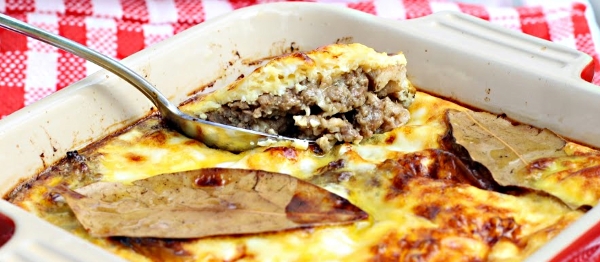
Bobotie (pronounced ba-boor-tea) is a mixture of mildly curried meat and fruit with a creamy golden custard-like topping, somewhat similar to to Greek moussaka. The dish melds sour, spicy, sweet and savory flavors to a whole greater than its parts.
Bobotie, the national dish of South Africa, has a history dating back to at least the 17th century, but its origins are hotly debated. Some researchers believe that the dish is of Dutch origin and was adopted by the "Cape Malays" of South Africa. The Cape of Good Hope was a Dutch Colony that existed from 1652 to 1795 when it was occupied by English forces (the same year that France conquered the Netherlands). During the years as a Dutch colony many people from other Dutch colonies migrated there by force or choice. "Cape Malays" were slaves and dissidents from Dutch colonies in the East Indies. Historians who oppose the view that bobotie was a purely Dutch invention hold that quite naturally Cape Malays brought their own cooking traditions with them. They view bobotie as an adaptation to local ingredients of the Javanese dish bobotak. Bobotak is normally a seafood dish that uses shredded coconut, not bread, as a thickener; but the general concept underlying the dish is similar. With ingredients from Africa, the Middle East, South Asia, Southeast Asia, and Europe bobotie is a great example of trans-cultural culinary innovation and borrowing.
Originally lamb and pork were favored meats, but bobotie is now often made with beef. The dish is often garnished with sliced almonds, walnuts, chutney and bananas and served with sambal chili sauce (from Southeast Asia). Recipes typically call for the use sultanas which are "white" or "golden" seedless raisins (like Thompson seedless raisins)that are a little less sweet than regular raisins. Curry powder and chutney can be obtained in either Middle-Eastern grocery stores (such as the Balboa International Market) or Indian groceries. Malt vinegar can be found in most supermarkets. It is a personal choice whether to use beef, lamb, or pork (or any combination thereof). Traditionally several bay leaves are arranged on the top of the dish.
Nelson Mandela said that bobotie was his favorite dish and rumor has it that it was the first thing he wanted to eat when he returned from his travels abroad while president of South Africa.
Ingredients:
- 2 pounds of ground beef, lamb or pork
- 3 eggs
- 2 medium onions chopped
- 2 cloves garlic, crushed
- 2 slices of soft bread with the crust removed(white or brown)
- 1 ½ cup milk
- ½ cup sultanas (golden raisins)
- 1 tablespoon oil (light olive oil)
- ½ tablespoon butter
- 1 ½ tablespoon curry powder
- 1 ½ tablespoon chutney (peach, mango or apricot)
- 1 tablespoon apricot jam
- 1 tablespoon Worcestershire sauce
- 1 teaspoon turmeric
- 1 ½ tablespoon malt vinegar
- several bay leaves
- 1 pinch of salt
Preparation:
- Soak bread in milk.
- Heat oil and butter in a large pan and sauté onions for 3 minutes.
- Add garlic and sauté until the onions are translucent.
- When onions are soft, add curry powder, salt, chutney, apricot jam, Worcestershire sauce, turmeric and vinegar and mix well.
- Drain and mash bread, reserving the milk.
- Add bread to pan together with meat and sultanas.
- Cook over low heat, stirring, and when meat loses its pinkness, remove from stove.
- Add 1 beaten egg, mix well, then spoon into a greased, 11 x 6 inches baking dish and level the top.
- Beat remaining eggs with reserved milk and the salt and turmeric.
- Pour the milk and egg mixture over meat mixture and decoratively arrange bay leaves on top.
- Stand dish in a larger pan of water (this is important to prevent drying out) and bake, uncovered, at 350 F for 1 hour or until the custard is set.
- Garnish with shredded coconut, chutney and or sliced almonds and serve with rice.
Lekker chow!
Recipe and Photo by Flavia Ferrarettot
- Details
- Hits: 3975
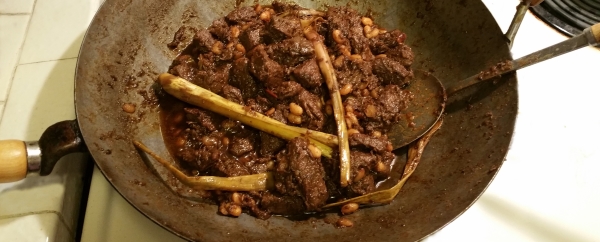
I had the immense pleasure to do my anthropological doctoral research in West Sumatra where I lived in a small (but important) farming community for several years. Typically rendang is made with water buffalo meat, but beef is also widely used. Some non-Minankabau cooks have made it with chicken, although we never encountered this variation in Sumatra. The cooking process turns the white coconut cream into an oily, but relatively dry dish. Cooking the dish for a much shorter period of time creates another fine, but more liquid dish known as kalio, which has a distinctly different (and milder) taste. In West Sumatra, rendang is more commonly cooked without beans, but some cooks there do add small white beans, and we think it's a nice touch. Many recipes call for the use of rehydrated red chilies to add spiciness, but it is more authentic and easier to use sambal olek, which now can be found in most grocery stores here in San Diego. Most rendang is very mild; other versions are spicier but chilies should not be the primary taste you experience. We like it spicier than what is typical, but overdoing the "sambal" will mask the other great flavors.
About the ingredients:
The Minangkabau are devout Muslims but also hold the distinction of being the largest matrilineal society in the world. In matrilineal cultures, family groups (lineages) are comprised of men and women who are exclusively related to each other through females. Matrilineal is not to be confused with matriarchy (rule by women), but Minangkabau women have great informal power in Minangkabau culture. Many important decisions require consensus from all adult members of the lineages. While formal positions of power are overwhelmingly male, such leaders cannot make decisions without full consent from the senior women of the matrilineal. Even though the Minangkabau language does not mark gender (which is true of several languages), gender role differentiation exists. What is different in Minangkabau society is the high value placed on women's roles; they are generally not seen as subservient to male roles or prerogatives. The fact that the Minangkabau are devoutly Muslim and have a matrilineal family system that contributes to female autonomy and power is more of a mystery to outsiders than it is to the Minangkabau themselves. Rendang plays an important role in ceremonial foods and can be bought at nearly all Nasi Padang restaurants. Water buffalo (kabau) and beef (sapi) are relatively expensive in West Sumatra, so it is considered a special food that is not generally eaten as everyday food.
Ingredients:
Main Ingredients:
- 1 1/2 pounds boneless beef short ribs (cut into cubes)
- 1/2 cup of white beans
- 2 tablespoons coconut oil
- 2 cups coconut cream
- 1 stalk of lemongrass, either pounded or deeply scored with a knife
- 2 tablespoons of tamarind sauce
- 6 kaffir lime leaves
- Salt to taste
Spice Paste:
- 5 shallots
- 1 inch piece of galangal
- 1 teaspoon of salt
- 1 tablespoon palm sugar
- 1 teaspoon of turmeric powder
- 1/2 teaspoon cinnamon
- 5 cloves garlic
- 1 inch piece of ginger
- 2 - 5 Tablespoons of Sambal Olek
Preparation:
- Soak the dried white beans in water over night.
- Chop the spices and blend them in a food processor until smooth.
- Heat the coconut oil in a large wok, add the spice paste and fry until aromatic.
- Add Coconut cream, beef, lemongrass, tamarind sauce, and kaffir lime leaves and bring to boil.
- Turn heat down to a simmer.
- Simmer the rendang stirring frequently for 3/4 hour.
- Test the sauce for sweetness and saltiness but remember that by the time the dish finishes cooking the flavors will intensify (so don't overdo the sugar or salt).
- Add the hydrated white beans and continue to cook and stir until the Rendang becomes dark brown and oily.
Serving:
Serve with white Jasmine rice. The rice must be somewhat sticky. The traditional way to eat rendang is with your fingers. Serve the rendang and rice side by side on a plate. For each individual bite, mix some rice with some of the rendang with your fingers and then bring your fingers to your mouth. It takes a tiny bit of practice, the mouthful of rice and rendang is held with the ends of your index, middle, ring fingers and your thumb. After bringing the food to you mouth, use your thumb to push the food into your mouth. It takes a bit of practice but once you figure it out your enjoyment of rendang will be heightened considerably. Green beans, or Chinese long green beans (which is what they have in Sumatra) go well with rendang. Like many dishes, rendang tastes even better a day later and keeps very well. It is one of the dishes that Minangkabau take along when they are traveling as it keeps well even without refrigeration.
Recipe by T. Johnston-O'Neill
Photos by S. Johnston-O'Neill
- Details
- Hits: 4459
Joomla!
Extensions
The Joomla! content management system lets you create webpages of various types using extensions. There are 5 basic types of extensions: components, modules, templates, languages, and plugins. Your website includes the extensions you need to create a basic website in English, but thousands of additional extensions of all types are available. The Joomla! Extensions Directory is the largest directory of Joomla extensions.
Components
Components are larger extensions that produce the major content for your site. Each component has one or more "views" that control how content is displayed. In the Joomla administrator there are additional extensions such as Menus, Redirection, and the extension managers.
Modules
Modules are small blocks of content that can be displayed in positions on a web page. The menus on this site are displayed in modules. The core of Joomla! includes 24 separate modules ranging from login to search to random images. Each module has a name that starts mod_ but when it displays it has a title. In the descriptions in this section, the titles are the same as the names.
Content Modules
Content modules display article and other information from the content component.
User Modules
User modules interact with the user system, allowing users to login, show who is logged-in, and showing the most recently registered users.
Display Modules
These modules display information from components other than content and user. These include weblinks, news feeds and the media manager.
Utility Modules
Utility modules provide useful functionality such as search, syndication and statistics.
Navigation Modules
Navigation modules help your visitors move through your site and find what they need.
Menus provide your site with structure and help your visitors navigate your site. Although they are all based on the same menu module, the variety of ways menus are used in the sample data show how flexible this module is.
A menu can range from extremely simple (for example the top menu or the menu for the Australian Parks sample site) to extremely complex (for example the About Joomla! menu with its many levels). They can also be used for other types of presentation such as the site map linked from the "This Site" menu.
Breadcrumbs provide users with information about where they are in a site.
Page 24 of 28








